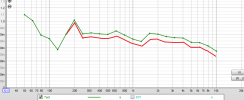Greetings to all,
Guys I would really appreciate your input on the following questions that I have with regards to acoustic treatment.
First off, let's set the scene:
Many thanks guys!
Guys I would really appreciate your input on the following questions that I have with regards to acoustic treatment.
First off, let's set the scene:
- Due to budget constraints I can only treat my back wall at this point (attached photo)
- I would only like to use safe materials with no toxic components or any breathable fibers, dust, etc.
- Idea is to replace existing canvasses (60cmx60cm each) with art panels
- Attached some measurement from one of my front speakers (FR, RT60, Waterfall graph).
- anyone knows of the EcoCore material from acoustimac is safe and absolutely risk free to be around? (attaching their claim)
- If I was to choose between having 3 panels 60cmx60cmx10cm (i.e. 4" thick) and having 3 panels 120cmx60cmx5cm (i.e. 2" thick but more surface area) for the back wall which should I go for?
- Is the area covered by my art canvasses as shown in the photo with respect to the back wall generally enough for acoustic treatment?
Many thanks guys!









